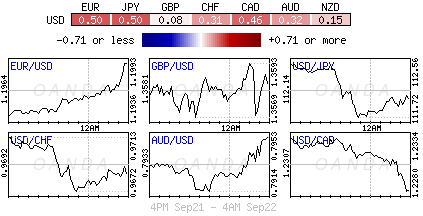September 22: Five things the markets are talking about
Global equities have retreated a tad overnight as the market purchased safe haven assets, including gold and yen (¥111.82), after N. Korea intensified their threats against the U.S. The EUR (€1.1957) remains better bid as German voters prepare to go to the polls this weekend.
N. Korea’s overnight threats have managed to temporarily divert attention away from this week’s monetary-policy decisions that have dominated the markets focus in the past three-sessions.
Expect investors to continue to eye speeches by Fed officials, as they may serve up some clues on what the central bank is thinking after bets for higher rates by year-end were raised following this week’s Fed meeting.
In Europe, U.K PM Theresa May is set to give a speech on her Brexit strategy in Florence (9:00 am EDT), while Germany is preparing to go to the polls on Sunday, with Chancellor Merkel expected to secure a fourth-term, although she may not win an outright majority.
In Vienna, OPEC prepares to meet today and there is mixed signals on whether they will discuss deeper or longer cuts.
Down-under, New Zealand heads to the polls tomorrow.
1. Stocks mixed results
In Japan, the Nikkei slipped from its two-year high overnight after N. Korea threatened to test a hydrogen bomb in the Pacific Ocean, again heightening tension with the U.S.
Despite the rhetoric, Japanese equities have recorded their second consecutive week of gains, led by financial shares, which have found support from sovereign bond yields backing up after the Fed’s policy statement midweek. The Nikkei slipped -0.3%, while the broader Topix Japan’s fell -0.2%.
Down-under, Australia’s S&P/ASX 200 Index added +0.5%, while S. Korea’s Kospi index slid -0.7%.
In Hong Kong, stocks posted their biggest decline in a month, erasing this week’s gains, as the market cashed out following S&P’s downgrade of China’s sovereign credit rating and N. Korea’s nuclear threats. The Hang Seng index dropped -0.8%, while the Hong Kong China Enterprises Index lost -0.9%.
Note: S&P downgrades Hong Kong sovereign rating to AA+ from AAA – outlook is revised to stable from negative.
In China, domestic equities recovered most of their early losses as investors played down S&P’s downgrade of China’s sovereign rating and N. Korea’s threat of another nuclear test. The blue-chip CSI300 index closed changed, while the Shanghai Composite Index shed -0.2%.
In Europe, regional indices trade mixed on continuing geopolitical tensions. Investors attention now turns to U.K PM May’s Brexit speech later this morning, and German elections over the weekend.
U.S stocks are set to open in the ‘red’ (-0.2%).
Indices: Stoxx50 +0.1% at 3,544, FTSE -0.1% at 7,256, DAX +0.1% at 12,613, CAC-40 +0.2% at 5,280, IBEX-35 -0.1% at 10,284, FTSE MIB +0.2% at 22,531, SMI +0.1% at 9,137, S&P 500 Futures -0.2%
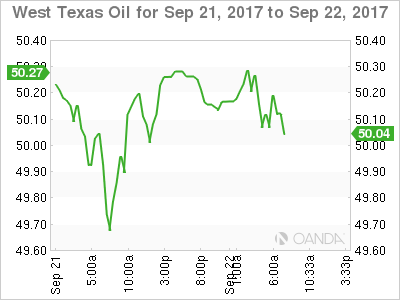
2. Oil prices higher as producers meet on output pact, gold rallies
Oil prices are a tad higher as the market waits to see whether OPEC and non-OPEC producers back an extension to output cuts beyond next March.
Brent crude futures are at +$56.51 a barrel, up +6c or +0.11%, while U.S West Texas Intermediate (WTI) crude futures are up +10c, or +0.2% at +$50.65 per barrel.
In January, OPEC and its allies agreed to reduce output by about -1.8m bpd until March 2018 in an attempt to empty inventories. The market is now anticipating an extension to that deal, possibly to the end of next year.
Note: Both contracts have risen more than +15% over the last three-months as global oil supply has tightened.
Ahead of the U.S open, gold has rebounded from its four-week low on sabre ratting rhetoric from N. Korea which prompted investors to seek safe-haven assets. Spot gold is up +0.4% at +$1,296.41 an ounce, after having hit a month low of +$1,287.61 Thursday.
Note: Bullion is down -1.7% for the week and heading for a second consecutive weekly decline.
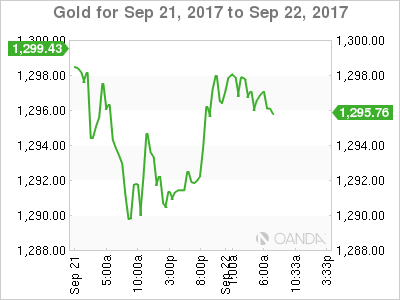
3. Sovereign yield curves flatten
It appears that the Fed is determined to hike in December even if policy makers realize that inflation prints undershoot.
This week, Fed Chair Janet Yellen indicated that the drop in core price pressures this year – below the Fed’s +2% target – a “mystery” while the board downgraded its long-run estimate for the fed-funds rate that keeps supply and demand balanced.
Since Wednesday, FI dealers have scrambled to price in a Dec. hike, pushing front-end U.S yields much higher (U.S 2’s backed up to +1.43% for the first time since 2008). The net result is a flatter U.S yield curve, with the yield spread between 2-year Treasury’s and U.S long-bond near the narrowest since June.
According to the CME, Fed fund future odds moved from pre-meet +50% to +73% possibility for a Dec. Fed rate hike.
Overnight, the yield on 10-year Treasuries fell -2 bps to +2.26%, the first retreat in more than a week, while in Germany the 10-year Bund yield declined less than -1 bps to +0.46%. In the U.K, the 10-year Gilt yield has advanced +1 bps to +1.375%, the highest in almost eight-months.
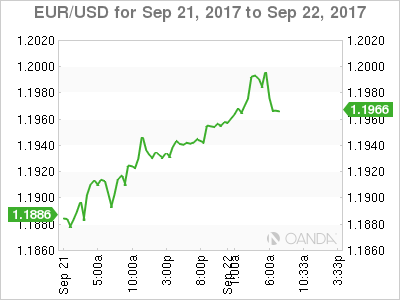
4. Where to for the EUR?
The EUR (€1.1957) remains better bid ahead of the U.S open, supported by stronger PMI data (see below) out of Germany, France and the Eurozone this morning.
Ahead of this weekend’s German election, market consensus believes that if Chancellor Merkel’s CDU party forms a coalition with the social democrats SPD party – the most likely scenario – then the EUR should trade little changed, focusing on regional data and ECB policy. However, if CDU allies itself with the liberal FDP and excludes the SPD, then the ‘single’ currency could eventually come under pressure as politics will most likely shift towards a German domestic agenda, rather than Europe priority.
Note: Forming a German coalition could take weeks of negotiation.
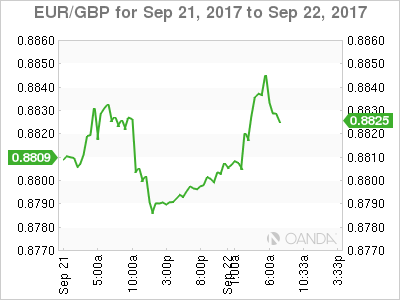
5. Eurozone composite PMI higher than expected
Euro data this morning revealed that this months flash composite PMI for the region came in higher than expected, rising to 56.7 from 55.7 as against a market consensus forecast for a dip to 55.6.
The jump was led by manufacturing, which suggests that the EUR’s (€1.1957) strength has not been much of a problem for growth.
Overall, today’s report is another positive surprise from the eurozone economy, which many had been predicting slowing in H1 after a strong six-months.
The pickup is the latest positive surprise from an economy that has already outperformed most expectations this year.
Note: IHS Markit says the average PMI for Q3 points to acceleration in growth to +0.7%.
